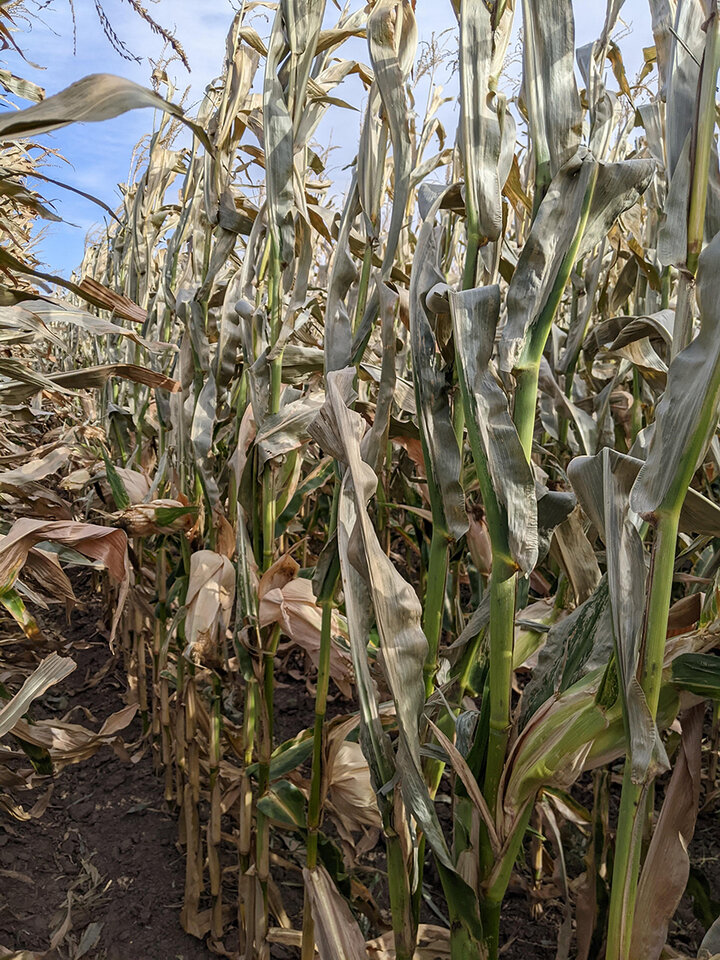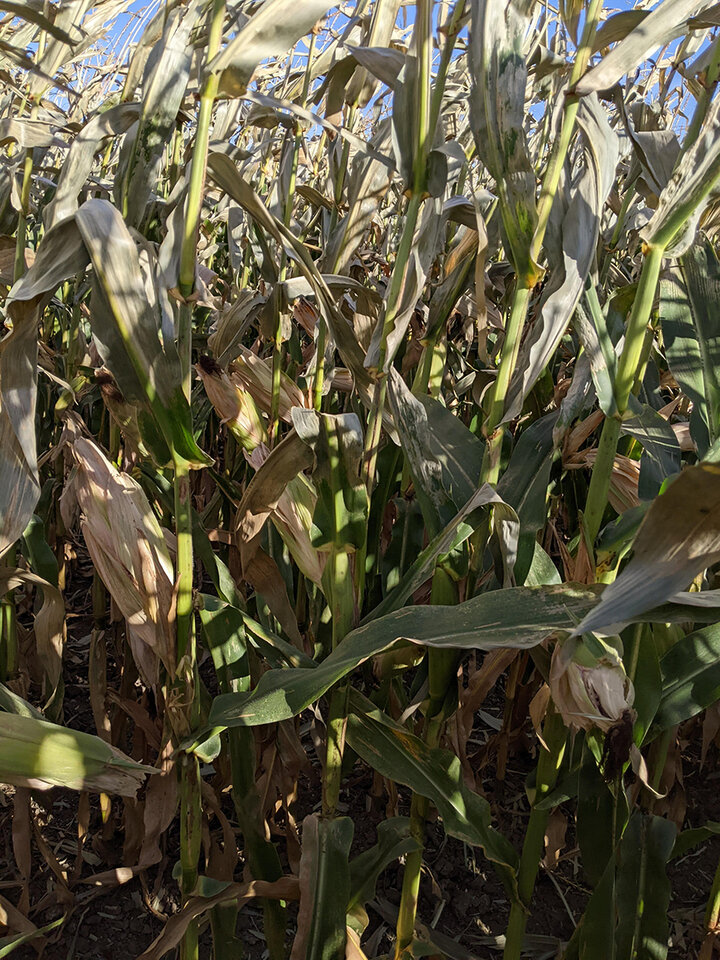Storm damage led to a high amount of replant crops in Nebraska this year. With freezing temperatures occurring on Oct. 8, 2022 and another frost anticipated this weekend, what can growers expect going forward?
Key Temperatures
- Temperatures at 31°F for a few hours will kill leaves, while temperatures at 28°F for a few minutes can kill the plant, including the stalk of corn and soybean.
- Four hours at 24°F or lower will freeze the growing point at the top of alfalfa.
- Temperatures down to 26°F will kill milo (sorghum) and sorghum species used for grazing.
Frost Damage Symptoms
Frost damage symptoms of water-soaked leaves and/or stems developed one to two days post-frost but it’s best to wait five to seven days to assess damage. This is important because the plants still looked fairly green on Oct. 9, but by Oct. 13, greater frost damage to plants was observed.
Higher soil moisture content (soil recently irrigated or receiving rainfall) prior to a frost event can aid radiant heating in the lower canopy, allowing the canopy temperature to be warmer than outside of the canopy. This was observed in fields in the York/Seward/Hamilton/Clay County areas where leaves in the lower halves of plants remained green following the Oct. 8 frost in fields that were less mature and had been recently irrigated.


Impacts on Corn
If only leaves are killed, the ear will continue to fill. Yield loss will be less because the stalk can continue to move carbohydrates to the ear. If only partial leaves are killed, photosynthesis will continue at a slowed rate. If the stalk dies, yield loss increases.
Keep an eye on stalk quality and also ear shanks, especially with the recent high winds experienced. Stalk quality will be compromised with premature frost, and with these larger ears, one may need to harvest at a higher moisture. Premature frost damage can also lead to pinched ear shanks as the ears turn down prematurely, increasing the potential for ear drop. We hope that’s not the case as so far, we’ve seen strong shanks and ear attachment, but it’s important to watch.
Around 85% of the corn surveyed in the York/Seward/Hamilton/Clay area pre-frost was in the ½ milk stage. A blessing at that stage is a lower level of potential yield loss. Estimated yield losses based on research from Afuakwa and Crookston conducted in 1984 where they used 80- and 105-day hybrids:
- Beginning Dent:
- Leaves and stalk killed = 40% yield loss
- Leaves only killed = 27% yield loss (23% via National Crop Insurance Services 100% leaf loss at this stage)
- ½ milk:
- Leaves and stalk killed = 12% yield loss
- Leaves only killed = 6% yield loss (8% yield loss based on National Crop Insurance Services 100% leaf loss at this stage)
A black layer will eventually form on the kernels, even if they are killed prematurely. This occurs when there’s no longer nutrient feeding from the placental cells where the kernel tips are attached to the cob. The pre-mature death results in lower test-weight grain (low 50s to high 40s) that can be chaffy. Test weights below 53 lb/bu rapidly reduce storage life. Plan on moving the corn to market before summer and aerating it frequently before then. Kernels can be smaller than normal, misshapen and may break easily when handled. Grain moisture content will be greater than 35%. It took four to nine more days of field drying to the 22-30% moisture range when corn was frozen before black layer compared to “normal” maturity.
The outer kernel portion will dry slower than the inside part, thus grain moisture will be deceiving. Plan on grain being 1-2% higher than handheld grain moisture testers. Also plan to dry frost-killed corn 1-2% lower than 14-15% and cool the grain as quickly as possible. Grain drying rates can range from 0.83 to 1.16% moisture less/day when whole plants die prematurely; thus, not too much different than if corn matured normally.
For those planning to dry corn, Thomison and Lauer share, “Dry frost-damaged corn at reduced air temperatures (below 160°F) and store at 14% (or lower) moisture. Dry corn as gently as possible, even if it is tempting to crank it up for higher dryer capacity. Also, use slow cooling methods after gas-fired drying to minimize quality problems. If possible, aerate stored grain to cool it to 20 to 30°F for winter storage (in the upper Midwest).”
Frost-damaged Corn for Livestock
It's not recommended to make silage from frost-damaged corn because of the excessive moisture in the plant and lower quality. Low test-weight corn and sorghum can be fed to livestock and we have more information on that here. Having a local feedlot as a market for taking high moisture corn can allow more timely harvest after a frost event before plants succumb to stalk rot.
Impacts on Soybean
A killing freeze for soybean is considered 28°F. Temperatures below 32°F can injure leaves and stems/pods/seeds are injured at 30°F. If at least one pod was mature on a soybean stem, the remaining seeds on the stem should mature fairly normally with normal-colored beans. If just the leaves were frozen but stems remain intact, the beans should continue to fill.
We have seen soybean pods that were green in color during a frost result in both round, green-colored beans or remain green, lima-shaped beans. The beans will be similar to corn in that handheld moisture testers will read 1-2% low compared to what they actually are. Depending on the percent of green beans at harvest, one may choose to bin the beans and aerate them to allow a reduction in the greenness and moisture in them over time before marketing.
Impacts on Sorghum
If the grain hasn’t reached physiological maturity (usually around 40-45 days after flowering), there can be reduced grain yield and reduced test weight when temperatures reach 28°F for around two hours. Sorghum plants aren’t normally completely killed by frost until temperatures reach 26°F. K-State research found yield reduction to be around 20% when the grain is at hard dough stage. They also found a 6.5-27% reduction in grain weight at hard dough and 27-52% reduction at soft dough. Most of the sorghum that we observed was past the hard dough stage.
If grazing sorghums, it’s best to keep livestock out of them from the first light frost to full hard frost and allow the tissue to completely dry for five to seven days post-hard freeze to avoid prussic acid poisoning.
Impacts on Alfalfa
Prior to the frost, several had asked about taking another cutting of alfalfa. We don’t recommend that within six weeks of a hard frost (24°F for four hours). One can take a cutting after a hard frost. One can also take a cutting in mid-October, even if a hard frost hasn’t yet occurred. The goal with this final cutting is to limit any new regrowth so the plant spends its energy preparing for winter dormancy.
One can also use growing degree days to determine the final cutting.
Summary
For the most part, we hope impacts from frost to pre-mature crops are minimal for our growers in regard to yield and test weight. We are blessed in Nebraska with a strong livestock industry and there’s opportunity for feeding wet corn and low-test weight corn and sorghum. Watch for stalk quality and the potential for ear drop in corn. The resources below provide additional information that could be beneficial as well. We wish you the best in harvesting these crops and finishing out the 2022 year!
Resources
Afuakwa, J. J. and R. K. Crookston. 1984. Using the kernel milk line to visually monitor grain maturity in maize. Crop Sci. 24:687-691.
Beckman, Ben. Managing late season alfalfa: https://extension.unl.edu/statewide/antelope/Ben%20Beckman%2010-18-21.pdf
Beckman, Ben, Jerry Volesky, and Todd Whitney. Oct. 11, 2022. Pasture and Forage Minute: Baling Soybean Residue, Winterizing Alfalfa by Growing Degree Days. https://cropwatch.unl.edu/2022/pasture-and-forage-minute-baling-soybean-residue-winterizing-alfalfa-growing-degree-days
Biehler, Connor and Ben Beckman. Oct. 1, 2021. Safely grazing frosted sorghums: https://beef.unl.edu/beefwatch/2021/safely-grazing-frosted-sorghums
Hurburgh, Charles, Rebecca Vittetoe, and Meaghan Anderson. Oct. 17, 2019. Frost damage to soybeans. https://crops.extension.iastate.edu/blog/charles-r-hurburgh-meaghan-anderson-rebecca-vittetoe/frost-damage-soybeans-0
Laborie, Erin. Oct. 1, 2019. Feeding light test-weight corn to livestock: https://beef.unl.edu/beefwatch/feeding-light-test-weight-corn-growing-and-finishing-diets
Licht, Mark and Charles Hurburgh. Oct. 7, 2019. Harvest consideration for frost-killed corn. https://crops.extension.iastate.edu/blog/charles-r-hurburgh-mark-licht/harvest-consideration-frost-killed-corn
Kandel, Hans. Sept. 10, 2020. Evaluating frost damage in soybean. https://www.ndsu.edu/agriculture/ag-hub/ag-topics/crop-production/crops/soybeans/evaluating-frost-damage-soybean
Nielsen, Bob. Oct. 2019. Frost or freeze damage to immature corn. https://www.agry.purdue.edu/ext/corn/news/timeless/FrostFreezeImmatureCorn.html
Staggenborg, Scott, Kevin Dhuyvetter, Dale Fjell, Richard Vanderlip. Aug. 1996. Fall freeze damage in summer grain crops. https://bookstore.ksre.ksu.edu/pubs/mf2234.pdf
Staton, Michael, Michigan State University Extension, and Kenneth Hellevang, North Dakota State University. Handling frost damaged soybeans. Sept. 17, 2019. https://www.canr.msu.edu/news/how_to_manage_frost_damaged_soybeans
Thomison, Peter, Ohio State and Joe Lauer, University of Wisconsin. 2019. Late-season Frost Effects on Corn: Grain Production (Adapted from Dr. J. Lauer, Univ. of Wisconsin) https://agcrops.osu.edu/newsletter/corn-newsletter/2019-33/late-season-frost-effects-corn-grain-production-adapted-dr-j

